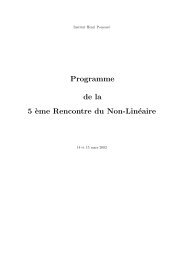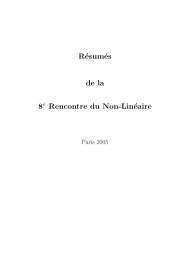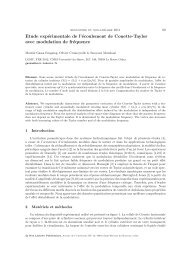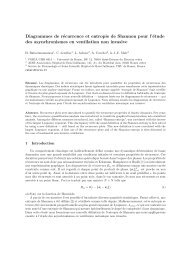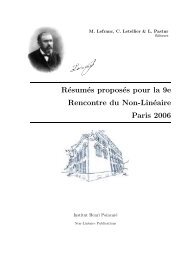Rencontre du Non-Linéaire
l'intégralité des comptes-rendus - science non linéaire
l'intégralité des comptes-rendus - science non linéaire
- No tags were found...
Create successful ePaper yourself
Turn your PDF publications into a flip-book with our unique Google optimized e-Paper software.
154 F. G. Schmitt et al.<br />
Remerciements. Les données sont issues de la base de données SOERE-INRA de Thonon-les-bains<br />
et ont été obtenues dans le cadre <strong>du</strong> suivi écologique <strong>du</strong> Léman dirigé et financé par la CIPEL (http:<br />
//www.cipel.org/). Nous remercions toutes les personnes de l’UMR-CARRTEL ayant travaillé à la<br />
collecte et au dépouillage des échantillons. Le code EMD en Matlab utilisé ici a été écrit par Dr Gabriel<br />
Rilling et Pr. Patrick Flandrin <strong>du</strong> laboratoire de Physique, CNRS & Ens Lyon, et est disponible ici :<br />
http://perso.ens-lyon.fr/patrick.flandrin/emd.html. Il a été adapté par Yongxiang Huang de<br />
l’Université de Shanghai. Cette étude fait partie <strong>du</strong> projet Bio-Asie FASCICLE (http://fascicle.<br />
cnrs.fr/accueil.html).<br />
Références<br />
1. R. V. Sole & J. Bascompte, Self-organization in complex ecosystems , Princeton University Press, Princeton<br />
(2006).<br />
2. D. Storch, P. A. Marquet & J. H. Brown, Scaling biodiversity , Cambridge UniversityPress, Cambridge<br />
(2007).<br />
3. S. Engen & R. Lande, Population dynamic models generating the lognormal species abundance distribution,<br />
Mathematical biosciences, 132, 169–183 (1996).<br />
4. B. J. McGill et al., Species abundance distributions : moving beyond single prediction theories to integration<br />
within an ecological framework, Ecology Letters, 10, 995–1015 (2007).<br />
5. A. Blarer & M. Doebeli, Resonance effects and outbreaks in ecological time series, Ecology Letters, 2,<br />
167–177 (1999).<br />
6. J. Halley & P. Inchausti, Lognormality in ecological time series, OIKOS, 99, 518–530 (2002).<br />
7. J. D. Reynolds and R. P. Freckleton, Population dynamics : growing to extremes, Science, 309,<br />
567–568 (2005).<br />
8. H. Utermohl, Zur Vervollkommung der quantitative Phytoplankton Methodik, Mitt. Internat. Ver. Theor.<br />
Anqew. Limnol., 9, 1–38 (1958).<br />
9. EN 15204, Water Quality - Guidance Standard on the Enumeration of Phytoplankton using Inverted Microscopy<br />
(Utermohl Technique), European Committee for Standardization, Brussels (2006).<br />
10. N. E. Huang et al., The empirical mode decomposition and the Hilbert spectrum for nonlinear and nonstationary<br />
time series analysis, Proc. R. Soc. London, 454, 903–995 (1998).<br />
11. P. Flandrin, G. Rilling & P. Gonçalvès, Empirical mode decomposition as a filter bank, Signal Processing<br />
Letters, IEEE, 11, 112–114 (2004).<br />
12. Z. Wu & N. E. Huang,Astudyofthecharacteristics of white noise usingtheempirical mode decomposition<br />
method, Proc. R. Soc. London, 460, 1597–1611 (2004).<br />
13. Y. Huang, F. G. Schmitt, Z. Lu, Z. & Y. Liu, An amplitude-frequency study of turbulent scaling<br />
intermittency using Hilbert spectral analysis, Europhys. Lett., 84, 40010 (2008).<br />
14. F. G. Schmitt, Y. Huang, Z. Lu, Y. Liu & N. Fernandez, Analysis of turbulent fluctuations and their<br />
intermittency properties in the surf zone using empirical mode decomposition, Journal of Marine Systems,<br />
77, 473–481 (2009).<br />
15. Y. Huang, F. G. Schmitt, Z. Lu, Z. & Y. Liu, Arbitrary order Hilbert spectral analysis for time series<br />
possessing scaling statistics : a comparison study with detrended fluctuation analysis and wavelet leaders,<br />
Phys. Rev. E, 84, 016208 (2011).





